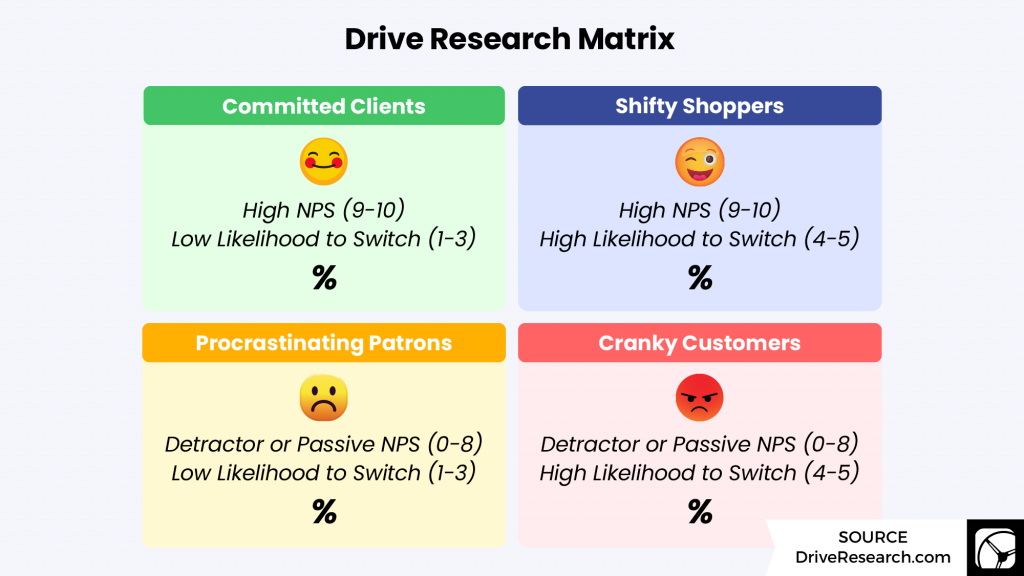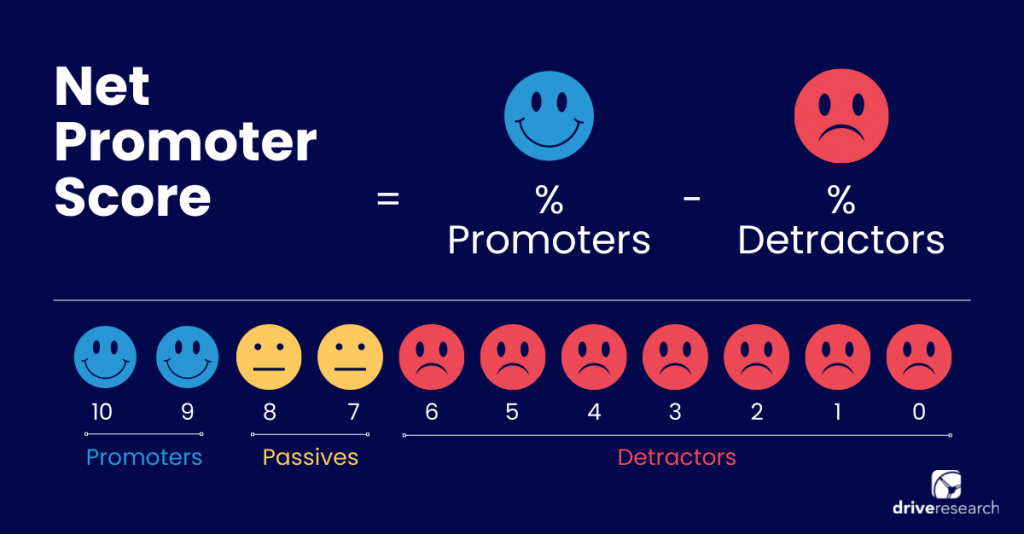
Improving customer satisfaction is the lifeline for the health of a business.
Organizations with poor ratings typically last only a short time or have notorious reputations in the market. Organizations with consistently high ratings flourish, grow, and have brands synonymous with A+ experiences.
Which one are you?
In this blog post, our customer satisfaction survey company delves into the insights provided by research experts to understand the significance of customer satisfaction, effective ways to measure it, and actionable strategies for elevating customer satisfaction levels.
By leveraging these research-backed techniques, businesses can forge stronger connections with their customers, foster brand loyalty, and ultimately position themselves for sustainable growth in the market.
Why Improve Customer Satisfaction?
Customer satisfaction is crucial for any business. It can have a significant impact on your brand image, customer loyalty, and business growth. Let’s dive into each of these elements.
Impact on Brand Image
Customer satisfaction plays a crucial role in building a positive brand image. If your customers are satisfied with your products or services, they are more likely to recommend your brand to their friends and family. This word-of-mouth marketing can help you attract new customers and build a loyal customer base.
On the other hand, if your customers are dissatisfied with your products or services, they are more likely to share their negative experiences with others. This can harm your brand image and reputation, which can be difficult to recover from.
Influence on Customer Loyalty
Customer satisfaction is also essential for building customer loyalty. If your customers are satisfied with your products or services, they are more likely to become repeat customers.
And repeat customers are the backbone of any business, as they provide a steady stream of revenue and are more likely to recommend your brand to others.
Although the same sentiment holds true for dissatisfied customers. For context, 91% of customers say they won’t willingly do business again with a company that left them unhappy.
Even worse, they may also switch to a competitor, which can further harm your business in the long run.
Effect on Business Growth
Improving customer satisfaction is one of the most crucial aspects of fostering business growth. Satisfied customers are more likely to become loyal customers, repeat buyers, and advocates for your brand.
Additionally, a track record of satisfied customers helps build a strong brand reputation. When customers trust your brand, they are more willing to try new products or services you introduce, expanding your market reach and potential for growth.
Measuring Customer Satisfaction with Market Research
Before making plans to improve customer satisfaction, it is first important to measure it. This is often accomplished by conducting customer satisfaction surveys and customer interviews.
This is because market research offers structured, quantifiable data, allowing businesses to analyze responses and measure customer satisfaction scores over time. This data-driven approach enables organizations to track improvements and identify trends accurately.
In this section, our market research team shares their best advice for measuring customer satisfaction with different market research methodologies.
1. Use a matrix to identify core differentiators and improvement areas
First, as part of your survey efforts, you need to identify about 8-10 critical factor(s) of choice as to why someone would choose your product or service.
These could be specific to your business or generalized categories such as quality, price, customer service, delivery time, accuracy, ease of use, etc.
In this survey, you must ask about these categories from two perspectives:
- How important is customer service when choosing a financial institution?
- How satisfied are you with the customer service at your current financial institution?
This allows you to leverage a 4-quadrant matrix to analyze the data on a single chart.
The output will give you a roadmap of what to market/message to your customers to pull business from competitors and keep them loyal, and identify the areas in your business you need to fix immediately to grow.

By plotting importance against satisfaction, you create four quadrants of insights.
Pay a little attention to the two bottom quadrants, considered lower priority and less actionable to improve customer satisfaction.
Essentially, they are areas where your customers are happy (not very important) and areas where your customers are unhappy (not very important). The latter is more longer-term (not ASAP) fixes.
2. Ask about Net Promoter Score (NPS)
If you are looking to measure customer satisfaction, one of the most important questions to include is: “How likely are you to recommend our products/services?”
Based on customers’ ratings from 0 to 10, you can calculate your Net Promoter Score (NPS).

The school of NPS teaches us that the most critical audience to fuel growth is the passives (those who rate you as a 7-8 on the 0-10 likelihood to recommend scale.
Do not ignore your detractors (0-6) and the areas they are unhappy with, but to shift a detractor into a passive or promoter takes a lot of time and resources.
The argument is that the slight return to turn an unhappy customer into a loyalist is a steep mountain to climb and one where the ROI could be better managed.
Fully explore the critical drivers of promoters and why they love your brand – quality, customer service, ease of access, etc. Then build out marketing plans and strategy to communicate those details to the passive audience to move them up the scale to a 9-10 rating.
Our Net Promoter Score company would argue the ROI is more substantial, and that turning a reasonably happy customer into a true loyalist takes less time.
3. Dive into frustration points as part of the customer journey
By understanding what causes minor or major frustration, you can identify and correct areas that cause a customer to switch to a competitor.
This can be accomplished through both qualitative and quantitative market research.
Step 1. Customer interviews
We suggest using both and starting with qualitative because it allows you to have an in-depth conversation with customers to truly understand the complete perspective of the frustration point(s). It will enable you and the moderator to ask why, dig deeper, and find the causes of dissatisfaction.
Maybe you learn it’s the inaccuracy of arrival dates for the shipment, a poor website checkout experience on mobile, lack of responsiveness of customer support, etc.
These can be fully explored with a good set of in-depth interviews (IDIs) or focus groups.
Step 2. Customer surveys
Then follow the qualitative research with a quantitative survey to validate and measure. Although the benefit of qualitative research is to explore, it will not produce statistically significant results that can be projected to our entire customer base.
If you only run 2 focus groups or 10 IDIs, you risk making assumptions and substantial changes to your operations based on the feedback from 10 people instead of 1000.
The survey will validate which frustration points are the biggest concerns and provide a data-driven plan to fix those. This research will help you reduce customer attrition and churn and provide ways to resolve issues before they fester.
4. Conduct competitive research
You may have strong customer satisfaction metrics from your surveys, but what if you found out all your competitors perform 15% better than you?
Context is everything in market research. Although you may think your customers are satisfied with your product or service, what if you knew you could do better?
Competitive research through a market survey, attitude and usage survey, and other studies can lend insights into competitive satisfaction metrics and provide a benchmark and context to your in-house data.
A competitive survey can showcase areas in your customer journey where your business performs better and worse than critical peers, all from the customers’ perspective.
I bet you would consider some changes if you found out that although your company touted a customer satisfaction (CSAT) KPI of 89% satisfaction, Competitor A had 92%, Competitor B had 94%, and Competitor C had 96%.
Recommended Reading: Conducting a Competitor Analysis [Ultimate Guide]
5. Leverage third-party market research where possible
A third-party market research company can provide background, insights from similar organizations they’ve worked with and, most importantly, ensure you gather objective and honest customer feedback.
Our market research company sees this all the time in a different space: employee surveys.
Companies often try to conduct these studies in-house to save on budget. They complete the survey and obtain a poor response rate (e.g., 10-15%), and all of the feedback is rosey and positive even though the management team and HR knows there are systemic issues.
This is response bias because employees with critical feedback tend to filter this information if they know it is going directly to the sponsor, or in most cases, they do not respond to the survey.
As a third-party market research company, we take over in Year 2 and often 2X-4X response rates and create a much more complete picture of the employee sentiment: the good, the bad, and the ugly.
The same is true with customer surveys.
Many customers are uncomfortable sharing poor feedback for fear of the criticism being addressed head-on or the criticism somehow impacting their relationship with the salesperson, service, etc.
So in these cases, when customers receive a survey directly from the sponsor, and they know who you are (without a middleman), they soften things.
Without negative feedback and ways to improve your product or service, you could be flying blind. Leveraging a third party allows you to dip into their expertise on the process and lets your customers know they can be honest, straightforward, and authentic with their feedback.
Strategies to Improve Customer Satisfaction
Implementing Customer Feedback
One of the most effective ways to improve customer satisfaction is by collecting and implementing customer feedback. As we discussed, you can do this by sending out surveys, conducting customer interviews, or monitoring customer reviews.
Once you have collected feedback, analyze it carefully to identify areas where you can improve. For instance, if customers frequently complain about long wait times, you can work on reducing wait times by increasing staffing or streamlining processes.
By implementing customer feedback, you demonstrate to customers that you value their opinions and are committed to improving their experience.
Get To Know & Understand Your Customer
To improve customer satisfaction, you need to understand your customers’ needs, preferences, and pain points. You can accomplish this by creating customer personas, conducting customer segmentation surveys, or analyzing customer data.
By understanding your customers, you can tailor your products and services to meet their specific needs, which can lead to higher satisfaction levels.
For example, if you run a restaurant, you can analyze customer data to identify the most popular dishes and adjust your menu accordingly. By doing so, you show customers that you care about their preferences and are committed to providing them with the best possible experience.
Offer Great Customer Support
Providing excellent customer support is another key method for improving customer satisfaction.
You can do this by training your staff to be knowledgeable, friendly, and responsive to customer needs. You can also offer multiple channels for customers to contact you, such as phone, email, chat, or social media.
By providing prompt and helpful support, you can resolve customer issues quickly and prevent them from escalating. In addition, you can use customer support interactions as an opportunity to gather feedback and identify areas for improvement.
Final Thoughts
Improving customer satisfaction is a never ending process. And guessing and suffering from a lack of information and data can be challenging.
There are always ways to improve, and making changes should be a continual agenda topic in all operations and strategy meetings.
Consider market research rather than making assumptions about where you excel and what you need to fix. A formal customer satisfaction program leveraging market research will give your team the data-driven insights and facts required to make educated decisions.
Market research is the most critical competitive differentiator for top-performing brands.
Contact Our Customer Satisfaction Company
Don’t let your competitors know more about your customers, and grow more quickly by stealing your market share. Leverage our research to drive increased revenue, expand into new markets, retain more customers, and outperform your competition.
Drive Research works with clients in 3 phases. First, let’s create a plan for your research and find out more about your needs. Then we put together a custom plan for you. Finally, if you decide to move forward with Drive Research, we execute that plan.
We’ve helped everyone from Amazon to start-ups research critical audiences to provide confidence in data-driven decisions.
To learn more about our services, contact Drive Research today.



